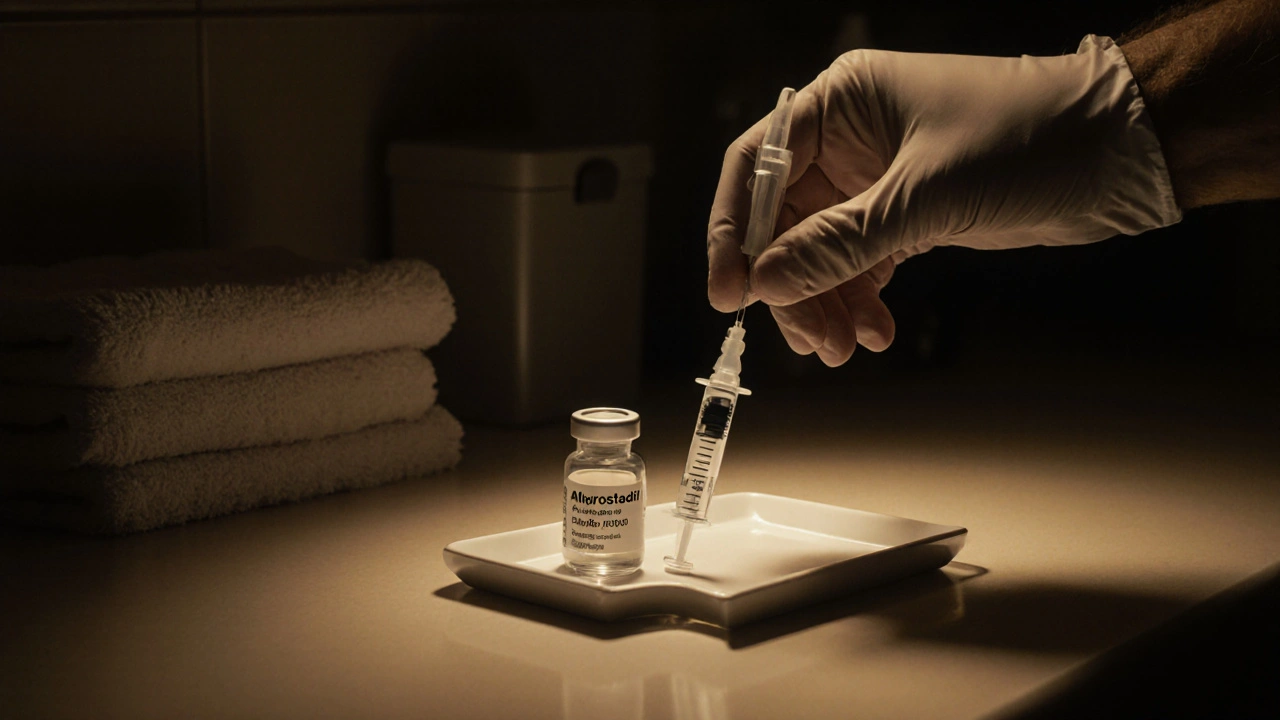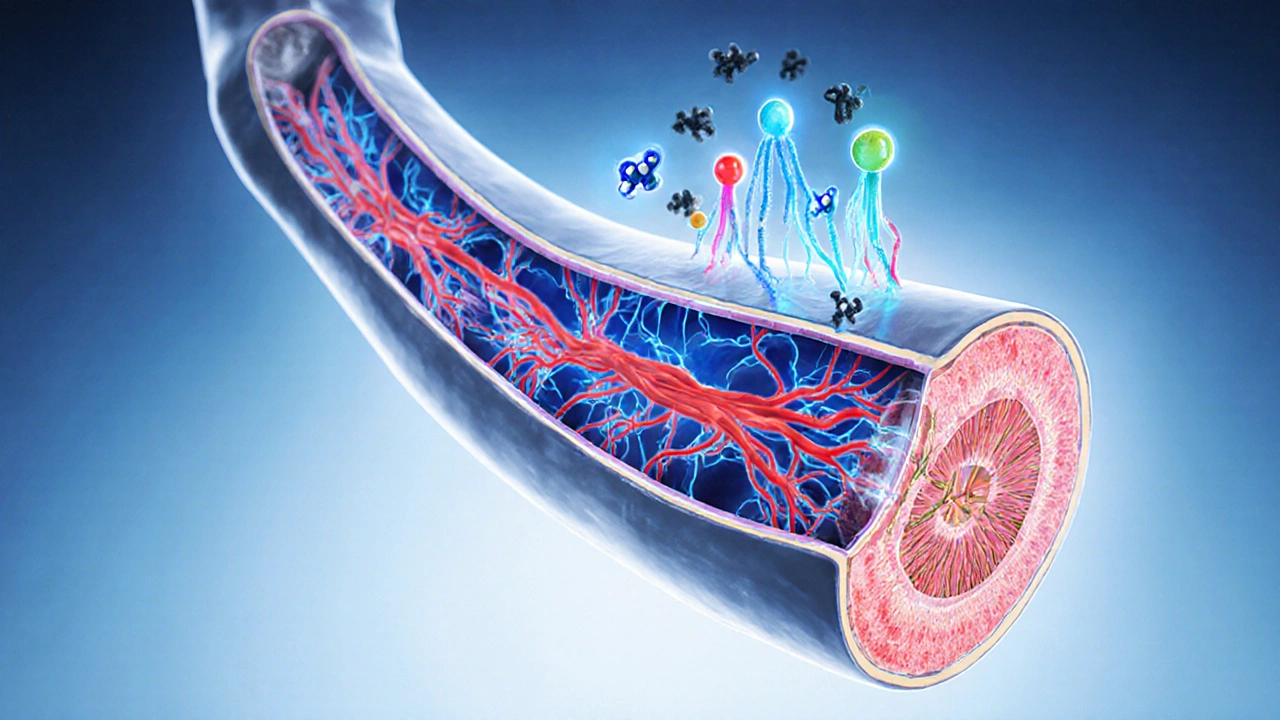Alprostadil vs Alternatives: Detailed Comparison for Erectile Dysfunction

Alprostadil vs Alternatives Comparison Tool
Select an attribute above to view detailed comparison information.
About Trimix
Trimix is a fixed-dose combination of Alprostadil, Papaverine, and Phentolamine. It offers synergistic effects that can provide better outcomes than individual agents, especially for men with insufficient response to Alprostadil alone.
Note: Trimix requires careful preparation and is typically administered by healthcare professionals.
Quick Takeaways
- Alprostadil is a synthetic prostaglandinE1 used for intracavernosal injection.
- Common injectable alternatives include papaverine, phentolamine, and the mixed formulation Trimix.
- Onset times range from 5‑10minutes (Alprostadil, Trimix) to 15‑20minutes (papaverine).
- Side‑effect profiles differ: Alprostadil often causes penile pain, while papaverine may lead to fibrosis with repeated use.
- Choosing the right agent depends on response, tolerance, cost, and physician guidance.
When men consider injectable therapy for erectile dysfunction (ED), the first name that pops up is Alprostadil. But it’s not the only player in the game. This guide walks you through how Alprostadil works, what alternatives exist, and which factors should steer your decision.
What is Alprostadil?
Alprostadil is a synthetic version of prostaglandinE1 (PGE1), a naturally occurring vasodilator. It received FDA approval for intracavernosal injection in 1995 and is marketed under brand names like Caverject and Edex.
Key attributes:
- Type: Prostaglandin analogue
- Primary use: Erectile dysfunction
- Route: Intracavernosal injection (directly into the penile corpora cavernosa)
- Typical dose: 2.5‑20µg per injection, titrated to effect
How Does Alprostadil Work?
Alprostadil binds to prostaglandin receptors on smooth‑muscle cells, triggering a cascade that raises cyclicAMP levels. The result is relaxation of the cavernous smooth muscle, increased arterial inflow, and retention of venous blood-creating an erection.
Because the drug acts locally, systemic side effects are rare, but local reactions (pain, bruising, priapism) can occur.

Administration Basics
Patients receive training on a tiny 30‑gauge needle and a pre‑filled syringe. The steps are:
- Wash hands and disinfect the injection site with an alcohol swab.
- Pinch the penile shaft to locate the corpora cavernosa.
- Insert the needle at a 90‑degree angle, avoiding the urethra.
- Inject the prescribed dose slowly.
- Apply gentle pressure for 1‑2minutes to minimize bruising.
- Dispose of the needle safely.
Most men achieve an erection within 5‑10minutes, lasting up to an hour.
Efficacy & Safety Profile
Clinical studies report successful erections in 70‑80% of men who use Alprostadil as a first‑line injectable. The main safety concerns are:
- Pain at injection site (15‑30% of users).
- Fibrosis from repeated high‑dose use (rare, mitigated by dose rotation).
- Priapism, a prolonged erection that needs urgent care (≈1%).
A 2023 meta‑analysis of 12 randomized trials confirmed that Alprostadil’s efficacy rivals oral phosphodiesterase‑5 inhibitors for men who do not respond to pills.
Injectable Alternatives Overview
When Alprostadil alone does not produce a satisfactory response, clinicians often add or replace it with other vasodilators. The three most common alternatives are:
Papaverine, a non‑specific smooth‑muscle relaxant derived from the opium poppy; Phentolamine, an alpha‑adrenergic blocker that reduces venous outflow; and Trimix, a fixed‑dose mixture of Alprostadil, Papaverine, and Phentolamine.
Each has a distinct mechanism, onset time, and side‑effect spectrum.
Detailed Comparison Table
| Attribute | Alprostadil | Papaverine | Phentolamine | Trimix (Alprostadil+Papaverine+Phentolamine) |
|---|---|---|---|---|
| Mechanism | ProstaglandinE1 receptor agonist | Phosphodiesterase inhibition (non‑selective) | Alpha‑adrenergic blockade | Combined vasodilation (adds up) |
| Onset | 5‑10min | 15‑20min | 10‑15min | 5‑10min |
| Duration | 30‑60min | 45‑90min | 30‑45min | 45‑120min |
| Typical dose (per injection) | 2.5‑20µg | 30‑180mg | 0.5‑5mg | Alprostadil 5‑20µg + Papaverine 30‑90mg + Phentolamine 0.5‑2mg |
| Common side effects | Pain, bruising, priapism | Fibrosis, pain, hypotension | Flushing, dizziness, priapism | Combination of above; higher efficacy, higher cost |
| Cost (US, 2024 average) | $30‑$45 per dose | $20‑$35 per dose | $25‑$40 per dose | $55‑$80 per dose |
How to Choose the Right Injectable
Picking an agent isn’t a one‑size‑fits‑all decision. Consider these factors:
- Response to Alprostadil alone: If you achieve a firm erection but need a longer duration, adding papaverine or phentolamine (Trimix) may help.
- Tolerance to pain: Some men find papaverine less painful than Alprostadil, but beware of fibrosis risk with high cumulative doses.
- Cost sensitivity: Stand‑alone agents are cheaper; Trimix packs more potency per injection but costs more.
- Medical history: Patients with uncontrolled hypertension should avoid phentolamine due to its vasodilatory effect.
- Ease of dosing: Alprostadil’s low microgram dosing can be intimidating; papaverine uses milligram doses, which some find easier to measure.
Work closely with a urologist or sexual health specialist. They can start you on a low dose, monitor response, and adjust the regimen over a few weeks.
Practical Tips & Common Pitfalls
Regardless of the agent, these best practices reduce complications:
- Rotate injection sites (left/right corpora) every session to avoid tissue damage.
- Never reuse a needle-single‑use syringes prevent infections.
- Keep a log of dose, time, and erection quality. Patterns help your doctor fine‑tune therapy.
- If you experience an erection lasting longer than 4hours, apply an ice pack to the perineum and seek emergency care.
- Store injectable vials at room temperature, away from direct sunlight; discard after the labeled expiration date.
Many men abandon injectable therapy after the first few attempts because they forget to rotate sites or feel embarrassed about the process. Setting a reminder on your phone can make the routine feel normal.
Frequently Asked Questions
Can I use Alprostadil with oral ED meds?
Combining Alprostadil with phosphodiesterase‑5 inhibitors (e.g., sildenafil) is generally safe, but the combined effect can heighten the risk of priapism. Always discuss dosage adjustments with a healthcare provider.
What is the main reason a doctor might switch me from Alprostadil to Trimix?
If Alprostadil alone produces a short‑lasting erection or causes significant pain, adding papaverine and phentolamine (Trimix) can improve both duration and firmness while allowing a lower Alprostadil dose.
Is papaverine safe for long‑term use?
Papaverine can cause penile fibrosis when used repeatedly at high doses. Periodic breaks, dose rotation, and ultrasound monitoring help minimize this risk.
How quickly does phentolamine work compared to Alprostadil?
Phentolamine’s onset is slightly slower (10‑15minutes) than Alprostadil’s 5‑10minutes, but it enhances venous occlusion, which can lengthen the erection when combined with other agents.
Do injectable therapies affect fertility?
Injectable vasodilators act locally in the penis and do not interfere with sperm production or hormonal balance. However, if you experience chronic inflammation, it’s wise to discuss it with a specialist.
Whether you stick with Alprostadil, switch to papaverine, add phentolamine, or opt for a Trimix blend, the goal is the same: a reliable, comfortable erection that fits your lifestyle. Armed with the facts above, you can have a focused conversation with your doctor and move toward an effective, personalized plan.
Dheeraj Mehta
Starting an injectable routine can feel daunting, but a steady schedule and a supportive partner make a big difference. Keep the focus on progress, not perfection :)
Oliver Behr
In the UK we often see patients favour papaverine for its cost‑effectiveness.
Tiffany W
From an evidence‑based urological perspective, the therapeutic index of alprostadil supersedes that of non‑selective phosphodiesterase inhibitors, thereby aligning with the ethical imperative to minimise iatrogenic risk. Moreover, the pharmacodynamic profile of prostaglandin E1 confers a rapid onset without systemic hypotension, which is paramount when evaluating risk‑benefit ratios. Clinical guidelines therefore endorse alprostadil as a first‑line injectable, reserving adjuncts for refractory cases. Practitioners ought to adhere to these standards rather than capitulating to anecdotal cost‑cutting measures.
Rajeshwar N.
Encouragement is nice, but the reality is that many men abandon injectables due to pain, and the data shows a non‑trivial dropout rate. Pain scores often exceed tolerable thresholds, especially with higher alprostadil doses. Rotating sites mitigates some issues, yet compliance remains a hurdle.
Louis Antonio
Honestly, the cheap papaverine hype ignores the fibrosis nightmare that shows up after a few months of repeated use. The literature warns that cumulative dosing can scar cavernosal tissue, compromising future responsiveness.
Kyle Salisbury
In many South Asian families, discussing sexual health remains taboo, which complicates access to proper instruction for injectable therapies. This cultural barrier often forces patients to rely on informal sources, increasing the risk of misuse.
Angie Robinson
That excuse is flimsy; clinicians must bridge the cultural gap rather than blame tradition. Proactive education and discreet counseling can dismantle the stigma effectively.
Emmons Kimery
You've got this! 😊 Remember to rotate sites and log each dose – the habit will pay off. Consistency beats occasional brilliance any day.
Mimi Saki
Thanks for the tip! 🙌 I'll set a reminder on my phone so I never miss a rotation.
Subramaniam Sankaranarayanan
Let me set the record straight about injectable ED therapy. First, alprostadil is not a miracle drug; it is a synthetic prostaglandin E1 analogue that works locally by binding to G‑protein coupled receptors on cavernous smooth muscle, thereby elevating cyclic AMP and causing vasodilation. Second, the notion that “any injectable will do” is scientifically unsound-each agent has a distinct pharmacologic fingerprint that dictates onset, duration, and side‑effect profile. Third, the cost advantage of papaverine or phentolamine is often offset by the need for higher dosing and the attendant risk of fibrosis or hypotension, respectively. Fourth, the so‑called “Trimix synergy” is a real phenomenon: combining alprostadil with papaverine and phentolamine exploits three complementary pathways, which can reduce the required dose of each component and thus mitigate adverse events. Fifth, proper technique is non‑negotiable; a 30‑gauge needle, a 90‑degree angle, and careful aspiration before injection prevent extravasation and hematoma formation. Sixth, patients must maintain a strict injection log, noting dose, time, erection quality, and any adverse sensations; this data drives dose titration and is invaluable during follow‑up visits. Seventh, the risk of priapism, while low (≈1 %), mandates an emergency plan: ice packs to the perineum and immediate medical attention if erection persists beyond four hours. Eighth, repeated high‑dose alprostadil can induce penile fibrosis, a reversible phenomenon if dose rotation is implemented. Ninth, clinicians should screen for contraindications such as sickle cell disease or severe cardiovascular instability before initiating any injectable regimen. Tenth, the psychological component cannot be ignored; many patients experience anxiety that diminishes efficacy, so counseling should accompany pharmacotherapy. Eleventh, insurance coverage varies widely; patients often need to navigate prior authorizations, especially for trimix, which is classified as a compounded medication. Twelfth, telehealth platforms now offer virtual training for self‑injection, expanding access for men in remote areas. Thirteenth, the emerging data on topical alprostadil creams suggests a possible non‑injectable alternative for low‑risk patients, though potency remains inferior. Fourteenth, the future may hold gene‑therapy or stem‑cell approaches, but for now, mastering the injectable regimen remains the gold standard for refractory ED. Fifteenth, never forget that shared decision‑making is the cornerstone of any successful treatment plan; patients must be fully informed of benefits, risks, and costs. In summary, an evidence‑based, patient‑centered approach that respects both the pharmacology and the individual’s context yields the best outcomes.
Kylie Holmes
Let's keep pushing forward, folks-every successful injection is a win!
Jennifer Wees-Schkade
If you experience priapism, immediate aspiration is non‑negotiable; delay can cause permanent damage. Use the emergency protocol without hesitation.
Fr. Chuck Bradley
Picture this: a quiet bedroom, a trembling hand, the faint click of the syringe-then, silence as the night holds its breath.